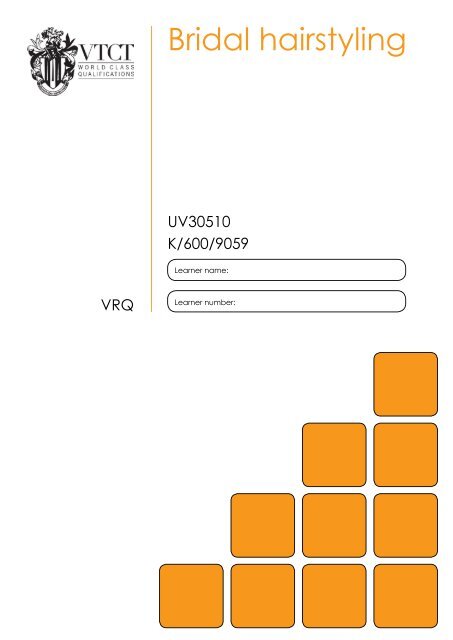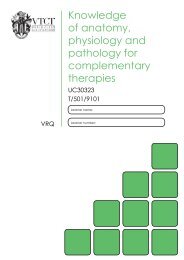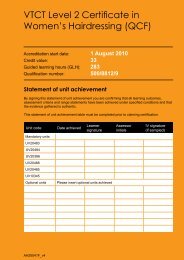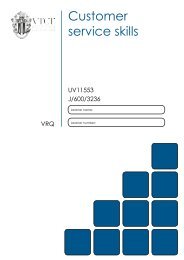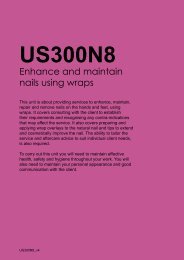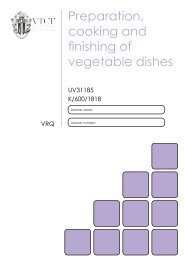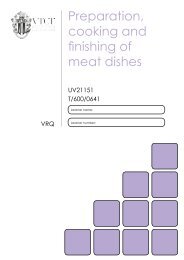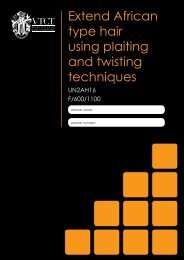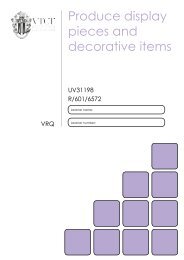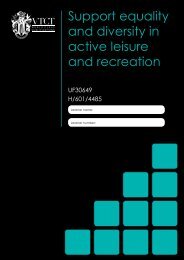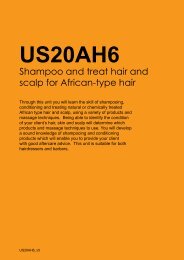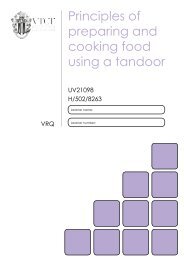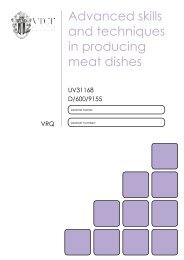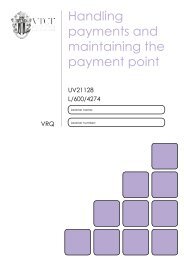UV30510 K/600/9059 - VTCT
UV30510 K/600/9059 - VTCT
UV30510 K/600/9059 - VTCT
You also want an ePaper? Increase the reach of your titles
YUMPU automatically turns print PDFs into web optimized ePapers that Google loves.
VRQ<br />
Bridal hairstyling<br />
<strong>UV30510</strong><br />
K/<strong>600</strong>/<strong>9059</strong><br />
Learner name:<br />
Learner number:
Statement of unit achievement<br />
<strong>VTCT</strong> is the specialist awarding body for the Hairdressing, Beauty Therapy,<br />
Complementary Therapy and Sport and Active Leisure sectors, with over 45<br />
years of experience.<br />
<strong>VTCT</strong> is an awarding body regulated by national organisations including<br />
Ofqual, SQA, DCELLS and CCEA.<br />
<strong>VTCT</strong> is a registered charity investing in education and skills but also giving to<br />
good causes in the area of facial disfigurement.<br />
By signing this statement of unit achievement you are confirming that all learning outcomes, assessment<br />
criteria and range statements have been achieved under specified conditions and that the evidence<br />
gathered is authentic.<br />
This statement of unit achievement table must be completed prior to claiming certification.<br />
Unit code Date achieved Learner signature<br />
Assessor tracking table<br />
Assessor name Assessor signature<br />
Assessor<br />
initials<br />
Assessors<br />
initials<br />
IV signature<br />
(if sampled)<br />
All assessors using this Record of Assessment book must complete this table. This is required for<br />
verification purposes.<br />
Assessor number<br />
(optional)
<strong>UV30510</strong><br />
Bridal hairstyling<br />
The aim of this unit is to develop your technical skill to an<br />
advanced level to create a variety of bridal hair styles that<br />
are personalised for each client.<br />
You will be able to analyse the capability of your clients’<br />
hair, with consideration for the style of dress to be worn – to<br />
ensure the hair style complements the bride’s image.<br />
You will choose from a range of products, tools and<br />
equipment, incorporate the use of ornamentation and<br />
accessories into the style, and advise your client on<br />
additional products or services for her to consider.<br />
<strong>UV30510</strong>_v5
Level<br />
Credit value<br />
GLH<br />
3<br />
4<br />
37<br />
Observation(s)<br />
3<br />
External paper(s)<br />
1<br />
© Habia
Bridal hairstyling<br />
Learning outcomes Evidence requirements<br />
On completion of this unit you will:<br />
1. Be able to prepare for bridal hairstyling<br />
services<br />
2. Be able to create a variety of bridal<br />
hairstyling effects<br />
1. Environment<br />
Evidence for this unit must be gathered in a<br />
real or realistic working environment.<br />
2. Simulation<br />
Simulation is not allowed in this unit. All<br />
‘Observation’ outcomes must be on real<br />
clients.<br />
3. Observation outcomes<br />
Competent performance of ‘Observation’<br />
outcomes must be demonstrated to your<br />
assessor on at least three occasions.<br />
4. Range<br />
All ranges must be practically demonstrated<br />
or other forms of evidence produced to<br />
show they have been covered.<br />
5. Knowledge outcomes<br />
There must be evidence that you possess<br />
all the knowledge and understanding<br />
listed in the ‘Knowledge’ section of this<br />
unit. This evidence may include projects,<br />
assignments, case studies, reflective<br />
accounts, oral/written questioning and/or<br />
other forms of evidence.<br />
6. Tutor/Assessor guidance<br />
You will be guided by your tutor/assessor<br />
on how to achieve learning outcomes and<br />
ranges in this unit. All outcomes and ranges<br />
must be achieved.<br />
7. External paper<br />
Knowledge and understanding in this unit<br />
will be assessed by an external paper.<br />
The criteria that make up this paper are<br />
highlighted in white throughout this unit.<br />
There is one external paper that must be<br />
achieved.<br />
<strong>UV30510</strong><br />
3
4<br />
Achieving observations<br />
and range<br />
Achieving observation outcomes<br />
Your assessor will observe your performance<br />
of practical tasks. The minimum number<br />
of observations required is indicated in the<br />
evidence requirements section of this unit.<br />
Criteria may not always naturally occur during<br />
a practical observation. In such instances you<br />
will be asked questions to demonstrate your<br />
competence in this area. Your assessor will<br />
document the criteria that have been achieved<br />
through oral questioning.<br />
Your assessor will sign off an outcome when all<br />
criteria have been competently achieved in a<br />
single client service.<br />
Achieving range<br />
The range section indicates what must<br />
be covered. Ranges should be practically<br />
demonstrated as part of an observation. Where<br />
this is not possible other forms of evidence may<br />
be produced. All ranges must be covered.<br />
Your assessor will document the portfolio<br />
reference once a range has been competently<br />
achieved.<br />
<strong>UV30510</strong><br />
Maximum service times<br />
There are no maximum service times that apply<br />
to this unit.
Outcome 1<br />
You can:<br />
a. Prepare yourself, the client and work area<br />
for bridal hairstyling services<br />
b. Use suitable consultation techniques to<br />
identify service objectives<br />
c. Evaluate the client’s existing hair length,<br />
texture and density<br />
d. Provide clear recommendations to the client<br />
based on the factors identified<br />
*May be assessed through oral questioning.<br />
Observations<br />
Be able to prepare for bridal hairstyling services<br />
Observation 1 2 3<br />
Date achieved<br />
Criteria questioned orally<br />
Portfolio reference<br />
Assessor initials<br />
Learner signature<br />
<strong>UV30510</strong> 5
6<br />
Outcome 2<br />
Be able to create a variety of bridal hairstyling effects<br />
You can:<br />
a. Communicate and behave in a professional<br />
manner<br />
b. Select and use hair styling products, tools<br />
and materials, ornamentation and added<br />
hair to achieve the desired look<br />
c. Use techniques that take into account the<br />
identified factors for the finished look<br />
d. Position yourself and the client<br />
appropriately throughout the service<br />
e. Follow safe and hygienic work practices<br />
f. Check the balance and shape throughout<br />
the service to ensure correct proportion<br />
g. Create the finished bridal style to the<br />
satisfaction of the client<br />
h. Provide suitable aftercare advice<br />
*May be assessed through oral questioning.<br />
Observation<br />
Date achieved<br />
Criteria questioned orally<br />
Portfolio reference<br />
Assessor initials<br />
Learner signature<br />
1 2 3<br />
<strong>UV30510</strong>
*You must practically demonstrate that you have:<br />
Range<br />
Used a minimum of 3 styling techniques Portfolio reference<br />
Setting<br />
Blow drying<br />
Use of heated styling equipment<br />
Use of alternative equipment<br />
Considered all influencing factors Portfolio reference<br />
Desired look<br />
The occasion for which the style is required<br />
Haircut<br />
Hair growth patterns<br />
Hair elasticity<br />
Head size and face shape and features<br />
Hair texture<br />
Hair length<br />
Hair density<br />
Completed all looks Portfolio reference<br />
Accessories to complete the look<br />
Added hair to complete the look<br />
40% of the hair up to complete the look<br />
*It is strongly recommended that all range items are practically demonstrated. Where this is not<br />
possible, other forms of evidence may be produced to demonstrate competence.<br />
<strong>UV30510</strong> 7
8<br />
*You must practically demonstrate that you have:<br />
Used a minimum of 5 dressing techniques Portfolio reference<br />
Rolls<br />
Barrel curls<br />
Knots<br />
Twists<br />
Plaits<br />
Pleats<br />
Curls<br />
Weaving effects<br />
Chignon<br />
Backcombing<br />
Back brushing<br />
Used a minimum of 3 accessories or attachments Portfolio reference<br />
Tiara<br />
Comb attachments<br />
Veils<br />
Flowers<br />
Hat<br />
Feathers<br />
Beads<br />
Ribbon<br />
Clip on diamante<br />
Daisy pins<br />
Headbands<br />
Nets<br />
Added hair<br />
*It is strongly recommended that all range items are practically demonstrated. Where this is not<br />
possible, other forms of evidence may be produced to demonstrate competence.<br />
<strong>UV30510</strong>
*You must practically demonstrate that you have:<br />
Used a minimum of 4 styling and finishing products Portfolio reference<br />
Setting lotion<br />
Blow dry lotion<br />
Mousse<br />
Oil<br />
Gel<br />
Activators<br />
Heat protector<br />
Moisturiser<br />
Holding spray<br />
Shine spray<br />
Dressing cream<br />
Wax<br />
Provided all types of advice Portfolio reference<br />
Maintenance of the style<br />
Removal of style<br />
Suitable aftercare products and their use<br />
*It is strongly recommended that all range items are practically demonstrated. Where this is not<br />
possible, other forms of evidence may be produced to demonstrate competence.<br />
<strong>UV30510</strong> 9
10<br />
Developing knowledge<br />
Achieving knowledge outcomes<br />
You will be guided by your tutor and assessor<br />
on the evidence that needs to be produced.<br />
Your knowledge and understanding will be<br />
assessed using the assessment methods listed<br />
below:<br />
• Observed work<br />
• Witness statements<br />
• Audio-visual media<br />
• Evidence of prior learning or attainment<br />
• Written questions<br />
• Oral questions<br />
• Assignments<br />
• Case studies<br />
Achieving the external paper<br />
Where possible your assessor will integrate<br />
knowledge outcomes into practical observations<br />
through oral questioning.<br />
The external paper will test your knowledge of the criteria highlighted in white. A pass mark of<br />
70% must be achieved. Criteria not achieved will be identified to your tutor/assessor. You will then<br />
be orally questioned or asked to produce other forms of evidence as all unit criteria must<br />
be achieved.<br />
Your assessor will complete the following table when the 70% pass mark has been achieved.<br />
Paper Date achieved Assessor initials<br />
1 of 1<br />
<strong>UV30510</strong>
Knowledge<br />
Outcome 1<br />
Be able to prepare for bridal hairstyling services<br />
You can:<br />
e. Describe the range of looks for bridal occasions<br />
f. Explain how to achieve the different looks for bridal occasions<br />
g. Describe the factors to be considered when styling bridal hair<br />
h. Explain the range of additional accessories available for bridal hair<br />
i. Explain the range of additional services and products available to<br />
support bridal hair styling<br />
j. Explain the health and safety considerations that must be taken<br />
into account<br />
k. Describe the different consultation techniques used to identify<br />
service objectives<br />
l. Describe the salon’s requirements for preparation of yourself, the<br />
client and work area<br />
*Assessor initials to be inserted if orally questioned.<br />
Requirements highlighted in white are assessed in the external paper.<br />
Portfolio reference /<br />
Assessor initials*<br />
<strong>UV30510</strong> 11
12<br />
Outcome 2<br />
Be able to create a variety of bridal hairstyling effects<br />
You can:<br />
i. Describe the correct use of products, tools and materials<br />
j. Explain the use of ornamentation in bridal hair styling<br />
k. Explain the advantages of added hair and hair pieces when styling<br />
bridal hair<br />
l. Describe how to remedy problems that may occur during the bridal<br />
hairstyling service<br />
m. Describe the aftercare advice that should be provided<br />
n. Outline safe and hygienic working practices<br />
o. State how to communicate and behave in a professional manner<br />
*Assessor initials to be inserted if orally questioned.<br />
Requirements highlighted in white are assessed in the external paper.<br />
<strong>UV30510</strong><br />
Portfolio reference /<br />
Assessor initials*
Unit content<br />
This section provides guidance on the recommended knowledge and skills required to enable you<br />
to achieve each of the learning outcomes in this unit. Your tutor/assessor will ensure you have the<br />
opportunity to cover all of the unit content.<br />
Outcome 1: Be able to prepare for bridal hairstyling services<br />
Preparation of self: Clothes (salon<br />
requirements for uniform, clean/ironed,<br />
non-restrictive, closed in low heel shoes),<br />
hair (clean, healthy, manageable, off<br />
face), personal hygiene (clean body, teeth,<br />
workable length clean nails, deodorant,<br />
no overpowering perfume/aftershave),<br />
personal protective equipment (gloves,<br />
apron, prevent dermatitis), minimal<br />
jewellery, positive attitude, ready to greet.<br />
Preparation of client: Remove client’s<br />
outer clothing (protect against damage),<br />
ensure client is relaxed and comfortable<br />
(posture, aids service), remove excessive<br />
jewellery (avoid damage to jewellery and<br />
skin), gown, towel, plastic cape, barrier<br />
cream, record card.<br />
Preparation of work area: Chair,<br />
trolley, work station, clean equipment,<br />
appropriate sterilisation (barbicide,<br />
autoclave, UV, sterilising spray), complete<br />
destruction of all living organisms on tools<br />
and equipment, disinfection (remove<br />
contamination from hard surfaces, large<br />
work areas, floors and work surfaces –<br />
using heat or chemical methods), safe<br />
professional presentation of tools and<br />
equipment, visual check on large and small<br />
equipment, check electrical equipment<br />
(portable appliance test), select height of<br />
chair/basin.<br />
Consultation techniques: Use a variety<br />
of methods to ensure suitability of service,<br />
product and technique.<br />
Questioning – open, closed, probing.<br />
Language – appropriate level for client,<br />
use of technical/non-technical language.<br />
Client expectations/needs – listen, clarify,<br />
advise, plan.<br />
History of hair – hair tests, touch, feel,<br />
look of hair.<br />
Advice – what will work, what will not?<br />
Visual aids – shade charts, style book,<br />
portfolio, collection of pictures.<br />
Evaluation of the client’s hair length,<br />
texture and density: Clarify suitability of<br />
length, texture, density for style, needs<br />
extra length (extensions), too long (cut<br />
prior to styling, use excess for padding),<br />
too thick (cut, reduce backcombing, choose<br />
flatter style), too thin (perm, hair pieces or<br />
extensions).<br />
Recommendations based on identified<br />
factors:<br />
Hair condition – (dry, greasy, normal,<br />
virgin, chemically treated), chemically<br />
treated hair will be more sensitive to<br />
backcombing and tension on the hair.<br />
Elasticity – (strength of hair), for poor<br />
elasticity avoid excessive tension, set the<br />
hair instead of blow drying.<br />
Porosity – (damage to cuticle layer), the<br />
ability to absorb moisture, if hair is porous<br />
style will not last.<br />
Texture (fine, medium, coarse hair) – too<br />
fine (hair padding may be used), coarse<br />
hair (heated rollers will allow the hair to<br />
mould easier), suitable products to achieve<br />
style.<br />
<strong>UV30510</strong> 13
14<br />
Outcome 1: Be able to prepare for bridal hairstyling services (continued)<br />
Length (short, medium, long) – the<br />
length needs to be suitable to achieve the<br />
style, too short to achieve the look (hair<br />
extensions), client may not wish hair to be<br />
cut short enough to achieve the desired<br />
look (set hair to reduce length, do not<br />
backcomb, use excess hair as padding).<br />
Density (fine, medium, thick) – thick hair<br />
(limit the amount of backcombing so the<br />
style can be achieved), sparse (thicken the<br />
hair e.g. extensions or perm, hair padding<br />
and backcomb will add extra volume to the<br />
style).<br />
Hair cut/style (uniform layer, one length,<br />
short graduation, long graduation) – hair<br />
cut/style needs to be suitable to be able to<br />
achieve the style.<br />
Growth patterns (cowslick, widows<br />
peak, nape whorl, double crown) –<br />
may influence choice of achievable style,<br />
temporary fix to disguise growth pattern.<br />
Skin tone (fair, medium, olive, dark) –<br />
use complementary coloured accessories<br />
and ornamentation.<br />
Face shape (oval, round, square,<br />
oblong, heart, pear) – oval (suitable all<br />
styles), round (create height/length, avoid<br />
width), square (height on top, keep sides<br />
flat, soften face with hair), oblong (avoid<br />
height, create width), heart (create width<br />
below ear level), pear (create width above<br />
ear level).<br />
Head size (large, medium, small) –<br />
hairstyle should complement, increase/<br />
decrease volume or curl.<br />
Existing curl (tight, soft, wave) –<br />
increase/decrease curl, tame, soften.<br />
Range of looks for bridal styles: Rolls,<br />
barrel curls, knots, twists, plaits, pleat,<br />
<strong>UV30510</strong><br />
weaving, chignon, classic/contemporary/<br />
avant-guard looks, hair up, hair down,<br />
combination of each.<br />
Range of accessories and<br />
ornamentation: Tiara, comb attachments,<br />
veils, fresh flowers, silk flower, hat,<br />
feathers, beads, ribbon, claw clips, clip on<br />
diamante, daisy pins, headbands, nets,<br />
coloured hair additions.<br />
Additional services available to support<br />
bridal hair styling:<br />
Services – conditioning treatments, hair<br />
cut, perming, coloured/natural extensions,<br />
relaxing hair, colouring techniques<br />
(block colour, highlights, slices, full head<br />
colour, placed application), colouring<br />
products (permanent, quasi-permanent,<br />
semi-permanent, temporary – mascara,<br />
sprays, gel).<br />
How to follow safe and hygienic working<br />
practices:<br />
Maintaining a safe salon – clean,<br />
tidy, safe standards of working, remove<br />
spillages, report slippery surfaces, remove/<br />
report obstacles, clear access to trolleys<br />
and equipment, clean/sterilise/disinfect<br />
tools, equipment and work surfaces, no<br />
smoking, eating, drinking or drugs in the<br />
salon, maintain professional personal<br />
hygiene.<br />
Personal protective equipment –<br />
wear protective equipment, avoid latex,<br />
powdered gloves, apron.<br />
Electricity at work – visual check of<br />
equipment, no trailing wires, portable<br />
appliance testing.<br />
Manual handling – moving stock safely,<br />
lifting, working heights, unpacking.<br />
Towels – wash regularly, clean for every
Outcome 1: Be able to prepare for bridal hairstyling services (continued)<br />
client, place dirty towels in covered bin.<br />
Reporting of injuries, diseases and<br />
dangerous occurrences – accident book,<br />
reporting diseases, log accidents.<br />
Control of substances hazardous to<br />
health – store, handle, use, dispose,<br />
replace lids, ventilation for vapour and<br />
dust, avoid over exposure to chemicals,<br />
use manufacturers’ instructions for use.<br />
Disposal of waste – sharps box, closed<br />
top bin, dilute chemicals with running water,<br />
environmental protection, salon policies for<br />
hazardous waste, single use items, recycle<br />
(empties).<br />
Product storage – check end date/<br />
packaging, store away from heat/damp/<br />
direct sunlight, empties avoid theft.<br />
Salon health and safety legislation<br />
and regulations: Health and safety at<br />
work, control of substances hazardous<br />
to health, reporting of injuries diseases<br />
and dangerous occurrences, personal<br />
protective equipment, electricity at work,<br />
manual handling, supply of goods and<br />
services, trade description, data protection,<br />
employers’ liability (compulsory Insurance),<br />
occupiers’ liability, local bye-laws (set by<br />
council), salon rules, code of conduct,<br />
observance by all staff.<br />
<strong>UV30510</strong> 15
16<br />
Outcome 2: Be able to create a variety of bridal hairstyling effects<br />
Professional communication in a salon<br />
environment: Try to avoid technical<br />
language, always respond, consider client<br />
confidentiality.<br />
Verbal – speaking (tone of voice, the<br />
language you use, how quickly and<br />
clearly), questioning (open, closed,<br />
probing).<br />
Non‑verbal – body language, positive<br />
attitude (your posture, facial expressions,<br />
hand gestures, the distance you<br />
stand), listening (be patient, try to be<br />
understanding).<br />
Written – visual aids, magazines, client<br />
records.<br />
Behave professionally in a salon<br />
environment: Follow health and safety<br />
practice and procedure, salon code of<br />
conduct, respect others, value client(s),<br />
co-operate with others (be sympathetic,<br />
fair, not aggressive), use appropriate<br />
language, avoid gossip, maintain<br />
confidentiality, polite/cheerful and friendly<br />
manner (friendly facial expressions, open<br />
body language, positive attitude, eye<br />
contact), sensible behaviour, team work,<br />
take pride in work, be punctual, employer<br />
and client loyalty.<br />
Styling products, tools, materials and<br />
added hair used to achieve the look:<br />
Styling products – mousse, holding spray,<br />
setting lotions, dressing creams, oils, gel,<br />
activators, moisturisers, wax, shine spray.<br />
Tools and materials – velcro/heated<br />
rollers, hairdryer, hood dryer, tongs,<br />
straighteners, molten browns, spiral tongs,<br />
crimpers, hair padding, bun rings, bands<br />
grips, fine pins, clips, tail comb, brush,<br />
dressing comb.<br />
<strong>UV30510</strong><br />
Added hair – variety of colours, variety of<br />
straight and curly hair pieces, clip-on, claw<br />
clips, pony tails, human hair, synthetic hair,<br />
pre-bonded single extensions, glued hair<br />
wefts, sewn in hair wefts.<br />
Position yourself and the client<br />
appropriately throughout the service:<br />
Correct posture of self and client to<br />
minimise fatigue and injury.<br />
Self – back straight, distribute weight<br />
evenly, feet slightly apart, use cutting stool<br />
(if required), no over stretching or bending.<br />
Client – position to achieve accurate<br />
cut, comfort and minimise risk of fatigue<br />
or injury, sat upright, back straight and<br />
supported, two feet on floor.<br />
How to follow safe and hygienic working<br />
practices:<br />
Maintaining a safe salon – clean,<br />
tidy, safe standards of working, remove<br />
spillages, report slippery surfaces, remove/<br />
report obstacles, clear access to trolleys<br />
and equipment, clean/sterilise/disinfect<br />
tools, equipment and work surfaces, no<br />
smoking, eating, drinking or drugs in the<br />
salon, maintain professional personal<br />
hygiene.<br />
Personal protective equipment –<br />
wear protective equipment, avoid latex,<br />
powdered gloves, apron.<br />
Electricity at work – visual check of<br />
equipment, no trailing wires, portable<br />
appliance testing.<br />
Manual handling – moving stock safely,<br />
lifting, working heights, unpacking.<br />
Towels – wash regularly, clean for every<br />
client, place dirty towels in covered bin.
Outcome 2: Be able to create a variety of bridal hairstyling effects (continued)<br />
Reporting of injuries, diseases and<br />
dangerous occurrences – accident book,<br />
reporting diseases, log accidents.<br />
Control of substances hazardous to<br />
health – store, handle, use, dispose,<br />
replace lids, ventilation for vapour and dust,<br />
avoid over exposure to chemicals, use<br />
manufacturers’ instructions for use.<br />
Disposal of waste – sharps box, closed<br />
top bin, dilute chemicals with running water,<br />
environmental protection, salon policies for<br />
hazardous waste, single use items, recycle<br />
(empties).<br />
Product storage – check end date/<br />
packaging, store away from heat/damp/<br />
direct sunlight, empties avoid theft.<br />
Balance and shape of style: Accurately<br />
establish the client’s wishes and<br />
expectations, stand back, view from all<br />
angles, perspective view, use mirrors<br />
(ensure consistent length, width, height).<br />
Initial consultation with client: Two way<br />
communication, use of visual aids (hair<br />
styles, accessories, pictures of dress),<br />
agree the finished look, consult with client<br />
throughout the service, forward planning,<br />
correct tools and equipment, trial run for<br />
occasion.<br />
Provide suitable aftercare advice:<br />
Important part of service, avoid technical<br />
language, maintain eye contact, suggest/<br />
advise/recommend, provide information<br />
(avoid humidity, avoid long periods of<br />
excessive tension, longevity of service,<br />
protect style during sleeping, use of<br />
additional products, removal of hair/<br />
head ornamentation, removal of pins,<br />
backcombing/back brushing, advice on<br />
massage and conditioning treatment after<br />
occasion).<br />
Styling products and when to use them:<br />
Used prior to styling, give hold, volume,<br />
body, shine, lustre, reduce frizz and<br />
static, smoothe and straighten, provide<br />
a protective barrier, prevent moisture<br />
penetrating hair, aid longevity of style.<br />
Gel – apply to wet hair, wet look, ideal for<br />
spiky styles, finger waves.<br />
Mousse – apply to wet hair, shake can,<br />
dispense small orange size into hand,<br />
distribute through hair, used for curly hair,<br />
add body, pre-blow dry.<br />
Setting lotion – apply to wet hair, direct<br />
from bottle, comb through, used for hold for<br />
wet setting.<br />
Blow dry lotion – apply to wet hair, spray/<br />
distribute direct from bottle, adds body,<br />
protects hair from heat/humidity.<br />
Moisturiser/oil – used on dry hair, African<br />
type hair, conditioning, adds moisture and<br />
shine, dispense and distribute evenly from<br />
container.<br />
Activator – can apply to wet or dry hair,<br />
activated by the use of heat, defines curl,<br />
adds moisture, shine, hold, ideal for dry<br />
sets.<br />
Heat protector – prior to the use of all<br />
electrical equipment, coats hair, protective<br />
layer, gives shine/definition.<br />
Finishing products and when to use<br />
them: Define, add shine, hold, separate<br />
hair, spike, protect, moisturise.<br />
Spray – protect face, hold can away from<br />
face, fine mist, holds style.<br />
Dressing cream – apply to palms and<br />
distribute evenly through lengths of hair,<br />
flattens hair, neatens style.<br />
Oil – apply to palms and distribute evenly,<br />
<strong>UV30510</strong> 17
18<br />
Outcome 2: Be able to create a variety of bridal hairstyling effects (continued)<br />
dry, coarse hair, makes hair more pliable,<br />
looks in better condition, stops tangling.<br />
Wax – apply with palms or finger tips,<br />
defines style, spikes, flicks.<br />
Gel – apply with finger tips, defines spikes.<br />
Moisturiser – apply to palms and distribute<br />
evenly, dry, coarse hair, makes hair<br />
more pliable, look better condition, stops<br />
tangling.<br />
Range of tools and equipment and<br />
the effects achieved: Conventional,<br />
non-conventional, winding root-to-point or<br />
point-to-root, on and off base dependant<br />
on required volume, implements used with<br />
added heat to create a variety of looks.<br />
Round brush (various diameters) – gives<br />
curl (smaller diameter = tighter curl), body,<br />
movement, volume.<br />
Flat brush – paddle, Denman, gives<br />
smooth, straight finish.<br />
Bristle brush – removes roller marks,<br />
dressing hair, smoothes, gives shine, good<br />
for fine hair.<br />
Vent brush – produces a soft causal<br />
broken up effect, ideal on short hair.<br />
Dressing comb – back-comb/tease<br />
the hair into style, used for all dressing<br />
techniques.<br />
Straighteners – smoothe/flatten the<br />
cuticles, straighten hair.<br />
Curling tongs – various sizes, produce lift,<br />
waves, curls.<br />
Hand dryer – removes moisture from the<br />
hair.<br />
Diffuser – diffuses the flow of air, allowing<br />
hair to dry naturally, increases natural curl,<br />
adds volume, movement, body.<br />
<strong>UV30510</strong><br />
Heated rollers – used on dry hair, various<br />
sizes of rollers, lift, curl, bounce.<br />
Rollers with pins – set curl, body/<br />
movement, lasts longer than blow dry.<br />
Bendy rollers – used on long hair, spiral<br />
effect curls.<br />
Velcro rollers – gives body, curl,<br />
movement, volume, bounce, doesn’t last<br />
long.<br />
Pin curl clips – types of pin curls (flat,<br />
coil, barrel curls), movement, curl, volume,<br />
body.<br />
Crimpers – fine crimp effect.<br />
Hot brush – gives body, curl, movement,<br />
volume, bounce, doesn’t last long, soft<br />
curls, flicks.<br />
Non‑conventional items – rick rack (spiral<br />
curls), rags (soft curls), chopsticks, straws,<br />
(zig zag effect) bendy foam rollers (soft<br />
curls), pre-formed plastic items (avant<br />
garde effect).<br />
Ornamentation in bridal hair styles:<br />
Used to decorate the style, complement<br />
the dress, match bouquet, enhance the<br />
style, create volume, personal preference,<br />
dress-up the occasion, add colour, hide<br />
grips.<br />
Advantages of added hair and hair<br />
pieces: Creates length, adds volume and<br />
density, colour, instant change, specific curl<br />
pattern, straight looks, ponytails, padding to<br />
support natural hair.<br />
How to remedy problems that may<br />
occur during service:<br />
Curl dropping – apply product, tighten<br />
with tongs, leave roller in situ.<br />
Hair too curly – use straighteners, large
Outcome 2: Be able to create a variety of bridal hairstyling effects (continued)<br />
rollers to tame curl.<br />
Tension incorrect – reduce if too tight,<br />
tighten if too loose.<br />
Hair fluffy, flyaway, static – use a<br />
moisturiser, dressing cream.<br />
Hair too heavy – use extra pins, secure<br />
hair with net.<br />
Hair too fine – use bun ring, hair padding,<br />
backcomb/back brush, padding.<br />
Too much hair – create a style where the<br />
excess hair can be used as padding.<br />
Ornamentation difficult to secure –<br />
create a pad of hair to pin to, wrap hair<br />
around ornamentation and pin.<br />
<strong>UV30510</strong> 19
20<br />
<strong>UV30510</strong><br />
Notes<br />
Use this area for notes and diagrams


